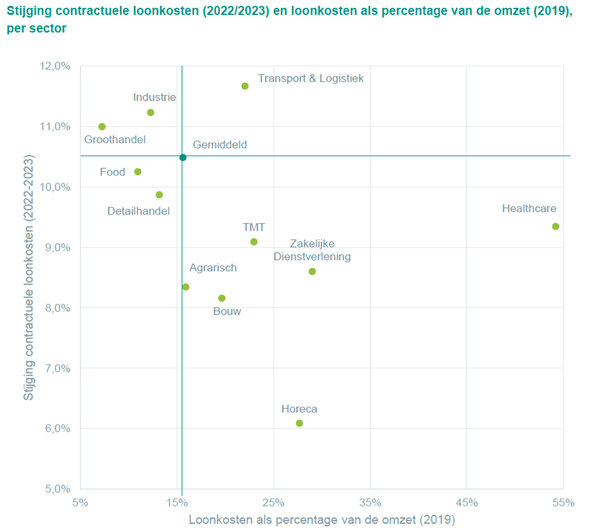- Opening hours : Monday to Friday from 8:30 to 17:00
We use cookies to analyze web traffic. No personal data is collected, and your visit is anonymized to protect your privacy.

Source: ABN AMRO sector forecast May 16, 2023
Due to tight labor markets and high inflation, businesses will face sharply rising labor costs in 2023. In 2022, collective bargaining wages already rose 3.2 percent; it was the largest increase since 2008. This year, labor costs are expected to rise by as much as 6.1 percent. For the entire business sector, this will lead to an increase in labor costs of about 17 billion euros, according to calculations by ABN AMRO. Meanwhile, lower consumer purchasing power and rapidly rising interest rates are causing the economy to cool down.
Entrepreneurs must therefore innovate to increase labor productivity. Given that staff shortages are expected to be structural, working more efficiently also provides long-term benefits.
The need to increase labor productivity is greatest in the most labor-intensive sectors. Indeed, especially those sectors in which labor costs are relatively high, the increase in collective bargaining wages can put pressure on margins. The Healthcare, Business Services, Leisure, TMT and Transport & Logistics sectors in particular are relatively labor-intensive, according to a comparison of labor costs with sales. In 2019, the cost of wages, salaries and social security contributions amounted to 15 percent of turnover for all sectors on average.
In healthcare, these costs were as much as more than half of turnover. In most sectors, wages are increasing rapidly. The cumulative increase in collective bargaining wages over the period 2022-2023 is about 10 percent, according to a combination of figures from CBS and the Algemene Werkgeversvereniging Nederland (AWVN). The transportation sector is the only sector that is both relatively labor-intensive and also has above-average wage growth.
Personnel costs were on average 22 percent of turnover in this sector in 2019. In 2022, this sector already experienced the strongest collective bargaining wage increase; 4.1 percent. In 2023, another 6.6 percent will be added, according to the AWVN. The wage increase could be even higher or lower, because not all collective bargaining agreements have been extended yet.
For now, ABN AMRO expects a collective bargaining wage increase of 5.3 percent in 2023 for all sectors on average. Total wage costs are expected to rise more sharply, by 6.1 percent according to the Netherlands Bureau for Economic Policy Analysis (CPB), due in part to the rapid increase in the minimum wage. On Jan. 1, 2023, the minimum wage increased 10.15 percent. On July 1, another 3.13 percent will be added. That also pulls up the wages of employees who were just above the minimum wage.
In the Leisure sector, the entire wage structure needs to be shaken up. The tightness in the labor market also leads to a faster increase in wage costs, in part because employees change jobs more often and in some sectors, such as the hospitality industry, more than the collective bargaining agreement can be paid.

In order to provide insight into the wage cost increase employers will face, ABN AMRO has included the increase in contractual wage costs in 2022 (CBS), as well as the indication for 2023 (AWVN). This is to make a better comparison between sectors in which wages will still be raised substantially in 2023, and sectors in which this has already happened in 2022. Source: CBS, AWVN, estimates and calculations ABN AMRO
0 Comments